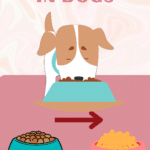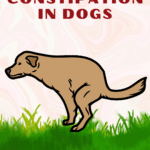Dogs have a curious habit of finding their way into things they shouldn’t. Swallowing things that aren’t good for them often results in problems with a dog’s digestive tract.
The top 5 digestive problems dog parents see are vomiting, diarrhea, vomiting & diarrhea at the same time, anorexia, and constipation.
Constipation is the rarest of the 5 digestive problems and is when a dog passes irregular poop on an infrequent basis. Knowing how to treat constipation in dogs is therefore very beneficial if your pup loves to eat sticks and rocks!
From adding fiber to a dog’s diet to giving them an enema, there are lots of ways to treat constipation in dogs both at home or with the help of your vet.
How to Treat Constipation in Dogs: 5 Home Remedies
1. Increased Water Intake
One effective way to treat dog constipation at home is to ensure your pet is getting enough water. Fluid is the natural stool softener!
Make sure there’s plenty of fresh water available, topping it up as soon as it starts to run low, as getting that fluid flowing through their body should improve a constipated dog’s condition.
Some dogs will be more reluctant to drink from a bowl than others—if this happens, you can try a raised bowl for comfort or even a water fountain.
Additionally, you can try adding bone broth or wet dog food to your dog’s food to add some extra moisture to their diet.
2. Dietary Fiber
Dietary fiber can also help improve the stool’s consistency and help it pass through your dog’s digestive system more easily.
Canned pumpkin or mashed carrots are great sources of fiber and are safe for dogs to eat. Additionally, one study found that figs were also effective at relieving constipation in dogs so you could try giving your dog a small piece to enjoy.
If your dog suffers from constipation often, you can speak to your vet about switching them to a high-fiber dog food.
3. Regular Exercise
Regular exercise can also help to stimulate your dog’s digestive system. Taking frequent walks and playing with them to get them moving has many benefits—including encouraging a bowel movement.
If you’re struggling to add in an additional walk each day, you can consider using a dog treadmill to get your dog’s step count up!
How much exercise a dog needs to stay healthy depends on many factors, such as breed, size, and energy levels. It’s recommended that most dogs have at least 30 minutes of exercise a day, but this can go up to a couple of hours for some.
It is, however, important to wait an hour after your dog eats, as heavy exercise right after a meal can cause bloating, which can be very dangerous in dogs.
4. Natural Laxatives
There are certain natural remedies you can give to your dog, like a small amount of olive oil or coconut oil mixed into their food. This acts as a gentle laxative. Make sure to start with a small dosage (around ¼ of a teaspoon for small dogs and a tablespoon for big dogs).
You can slowly increase this dose if it doesn’t seem to be doing anything, though you should always err on the side of caution.
Never start with a big dose first in case your dog has an adverse reaction, especially if they’ve never had it before.
5. Check Your Dog’s Rectum
Long-haired dogs sometimes experience constipation when the hair around their rectum becomes matted. This causes a blockage and doesn’t allow for the waste to be effectively removed.
If you do notice matted hair around your dog’s rectum, you can try to remove it by giving your dog a warm bath to loosen the hair.
When the hair is loose, you can try to cut it away with scissors being extra careful not to nick your dog in the process.

What Causes Dog Constipation?
Whether you’re dealing with one bout of dog constipation or it keeps coming back, it’s important to be aware of the main causes to reduce the risk in the future.
Some issues are easy to fix—for example, a dog’s diet. If your dog loves to eat items that are difficult to digest, they can become constipated as their body isn’t able to break these items down.
It could also be that your dog isn’t getting enough exercise or water, so it’s important to consult your vet about the appropriate level of exercise for your dog and make sure they have fresh water available at all times, as recommended by experts.
Your dog’s emotional state could also be playing a part in their constipation. Dogs may become reluctant to use the bathroom if they are anxious or stressed. Holding in their poop can lead to constipation so reading your dog’s body language to see how they’re feeling is important.
Some more serious issues could be causing your dog’s constipation. Underlying medical conditions like hormonal imbalances, anal gland issues, and intestinal blockages can be the culprit. If you suspect these, it’s important to call your vet right away.

When to See Your Veterinarian
So how do you know when dog constipation needs vet attention, and not just at-home remedies?
If your dog’s constipation is accompanied by other symptoms such as:
- Vomiting
- Lethargy
- Behavioral changes such as aggression
- A lack of hunger
- Bloody stool
- Weight loss
- Vocalizing pain
You should see a veterinarian, as it could be a sign of something more severe than just a lack of exercise or an upset stomach.
This is also true if your dog hasn’t had a bowel movement in 48-72 hours. If it starts to pass two days, it can be dangerous, so calling your vet is the best move.
Most constipation only lasts for a day or two, but some constipation needs expert attention and the use of a dog-friendly enema.
Your vet may suggest a particular wet food that might be good for your dog. If they do diagnose an underlying condition, the treatment will depend on what’s wrong. Intestinal blockages, for example, always require surgery, whereas something like a hormonal balance would require medication.
Final Thoughts
Your dog’s constipation could be easily fixed at home, or it could be a more severe condition. If constipation is the only symptom, you can try some at-home remedies to see if it improves within a day or two.
If it continues or is accompanied by other systems, then it’s time to give your vet a call.




